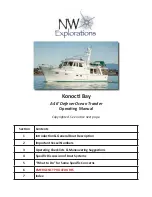
8
9
williamsjettenders.com
williamsjettenders.com
English
English
WARNING.
Never perform high speed and extreme maneuvers
which could result
in loss of control.
WARNING.
Always attach the kill cord lanyard to your leg.
Removal of the lanyard
will stop the engine in the event of an emergency. Always test the operation of the lanyard
each time you use your boat.
WARNING.
Manoeuvrability of the boat is restricted while decelerating.
Familiarize
yourself with the boat’s handling.
This boat uses a water-jet propulsion system and has unique characteristics in steering. The
throttle produces thrust from the jet pump, the directional control is provided by opening the
throttle and turning the wheel in the direction of your turn. High thrust will turn the boat sharply;
low thrust will produce less turning force. There is no rudder, so while underway there is no
steering without thrust.
If weed or debris gets caught in the jet unit during use cavitation can occur, causing a decrease
in forward thrust. If this condition is allowed to continue the engine may overheat, resulting in
serious damage. If there is any sign of debris or weeds etc. blocking the jet, remove the boat
from the water.
Remove keyswitch and kill cord. Remove all debris from around the
jet unit.
DO NOT make repeated attempts to start a blocked or
jammed tender as engine damage may occur.
In case of difficulty
consult your Williams authorized dealer. (A full list of authorized dealers/
engineers is available at williamsjettenders.com)
Recovery
CAUTION.
Do not attempt to lift or recover the tender by
the transom.
Any stern-up angle will cause water to enter the
engine from exhaust system and will result in serious engine damage.
Towing Valve
CAUTION.
Risk of engine flooding exists.
Towing valve fitted. Valve must be in
CLOSED position when your tender is being towed and OPEN position when your tender
is being used. Failure to observe correct valve position will result in serious engine damage.
Mooring
CAUTION.
Do not leave the Minijet moored for extended periods
as this may result
in an accumulation of marine growth and loss of performance.
Beaching
CAUTION.
DO NOT operate in less than 0.95 m/3 ft of water as debris may enter
the jet unit. DO NOT drive Minijet onto beach.
Stop engine before beaching as
damage to pump/engine cooling system may occur.
After beaching, move boat into deeper water and rock from side to side several times to
remove sand from intake area – failure to do so could cause damage to jet unit.
Trim
CAUTION.
Do not overload the boat.
At all speeds be aware of trim and keep weight
evenly distributed.
General
CAUTION.
Operate the boat with due care and at a speed appropriate to the sea
conditions.
Be aware of local laws and restrictions. Always carry out a visual check of
the boat and its components prior to use. Adhere to the maintenance schedule.
New Engine Break-in Period
Consult your BRP engine operator’s manual.
A break-in period of 5 hours is required before continuous operation at full throttle. To achieve a
good break-in, a maximum of
3
/
4
throttle should be observed, however, brief acceleration and
speed variations contribute to a good break-in. Williams suggest that after the first 10 hours of
operation, the engine be checked by an authorized Williams dealer.
The break-in period is very important and must not be neglected.
Fuelling
As part of its pre-delivery inspection your new Minijet has been fully tested and
drained of fuel.
•
Ensure ignition is in OFF position.
•
Re-fuel in a ventilated area.
•
Do not overfill the tank; be careful not to spill fuel.
•
Tighten fuel cap securely after re-fuelling.
•
Open engine hatch and inspect bilges after re-fuelling.
•
The filler cap has an integral breather.
Do NOT hose around the fuel filler area as water may enter the fuel tank.
Minimum Octane Rating
CAUTION.
Do not use fuel from fuel pumps labeled E85.
Use of fuel labeled E15 is
prohibited by US EPA Regulations.
North America
Rest of the World
RON+MON/2:
87
91
RON:
92
95
900 (ACE)
•
•*
900 (ACE)
•
•*
*
For optimum engine performance
Fuel containing Ethanol can result in problems in the fuel system and engine, resulting in:
•
Starting and operating difficulties.
•
Deterioration of rubber or plastic parts.
•
Corrosion of metal parts.
•
Damage to internal engine parts
Summary of Contents for Minijet 280
Page 1: ...Owner s Handbook...























